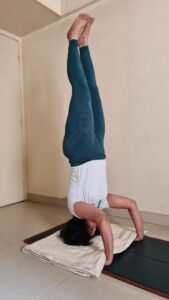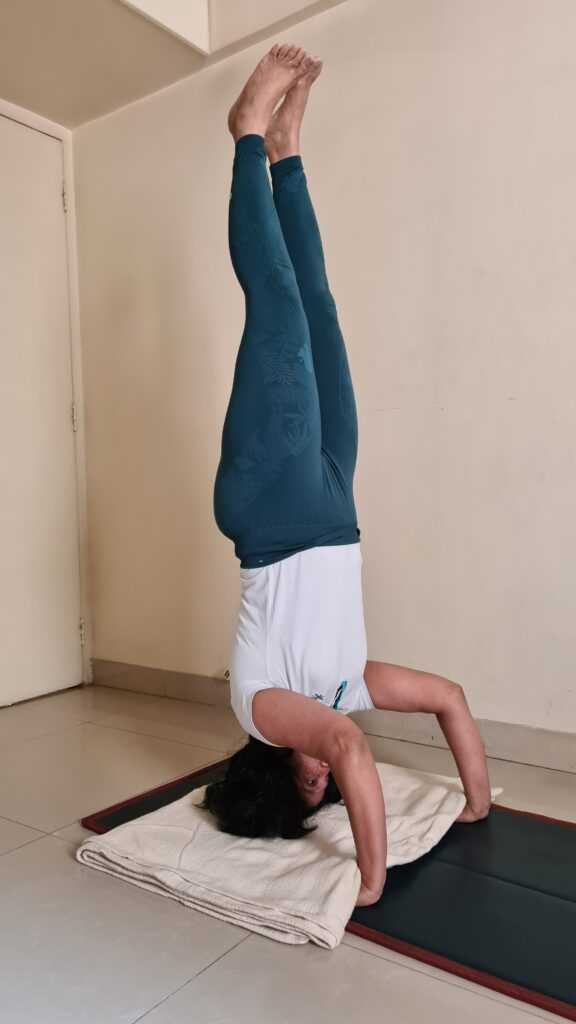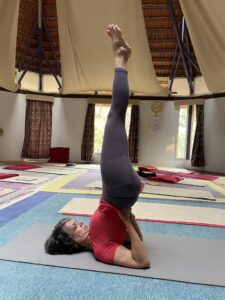Inversion Yoga: Your Path to Health and Inner Balance
“−−On the first day he should remain [only] a little while in the headstand, with legs in the air. Increase the practice time a little each day. After six months gray hair and wrinkles disappear. He who practices three hours a day conquers death,” Hatha Pradipika claims. Is this tempting enough to bring inversion postures in our practice? Unfortunately, a daily practice of three hours sounds a bit too difficult. Let’s keep aside the death-conquering part. Just tackling “gray hair” and “wrinkles” itself is a good enough reason. Still, not many students are willing to venture into this area of turning oneself upside down.

The Fear of Being Upside-Down
What is so difficult about learning inversions? Purposely turning ourselves upside down is contrary to our human physical locomotion nature. The transition from childhood to adulthood has taught us to be “upright”. We have forgotten the playful ways of experimenting. Most probably, it is the fear in our minds which restricts our bodies from turning upside-down.
Just as yoga gently encourages us to move away from any unconscious habitual patterns, the invitation to invert is simply another way to step out of one’s comfort zone.
How Inverted Poses Promote Health and Wellbeing
Inverted poses are an important group of asanas. Inverted asanas reverse the action of gravity on the body; instead of everything being pulled towards the feet, the orientation shifts towards the head. As you age, fat and skin start to sag, which physically and, perhaps emotionally, drags you down.
As gravity pulls your body down, tissues and fluids in your body pool towards the lower extremities — resulting, potentially, in varicose veins. Anatomist David Coulter, PhD explains in a Yoga Journal article that “when you turn upside down, the fluid in your lower body drains better to the veins and lymph vessels, helping to clear up congestion in all parts of your body. Blood goes quickly to the heart and circulation improves, which may help your body get rid of waste products more efficiently and enhance the flow of nutrients to working cells. Fluid and blood that tends to concentrate in the lower lungs due to gravity is distributed to the upper lungs during inversions and this may enhance the health of your lung tissue.”
Continued practice of shoulder stand eradicates common colds and other nasal disturbances. Due to the soothing effect of the pose on the nerves, those suffering from irritation, shortness of temper, nervous breakdown, and insomnia are relieved. The asana is recommended for urinary disorders and uterine displacement, menstrual trouble, and hernia. It also helps to relieve epilepsy, low vitality, and anemia. It activates the abdominal organs and relieves people suffering from stomach and intestinal ulcers and severe pain in the abdomen.
Reversing the pull of gravity on the organs, especially the intestines, helps to cleanse them and overcome problems of the liver, kidneys, stomach, intestines, and reproductive system. Headstand increases gastric fire and produces heat in the body. When done properly, the headstand helps the spine become properly aligned, improving posture, facilitating good breathing, and reducing muscular stress. The weight of the abdominal organs on the diaphragm encourages deep breathing, which gently massages the internal organs. Sirsasana is used to treat asthma, hay fever, diabetes, headaches, anxiety and menopausal imbalance.
Inversions give you temporary relief from the pull of gravity. Similarly, on the emotional and psychic levels, inverted asanas turn everything upside down, throwing new light on old patterns of behavior and being.
Inversion postures build the core strength as well as the strength of shoulders and arms—especially for women who tend to be stronger in the lower body, inversions create body balance by developing upper body strength.
Generally, these practices improve health, reduce anxiety and stress, and increase self-confidence. They also increase mental power, and concentration and stimulate the chakras. There are four major systems in the body that the practice of inversions positively influences: cardiovascular, lymphatic, nervous, and endocrine. The circulatory system is comprised of the heart, the lungs, and the entire system of vessels that feed oxygen and collect carbon dioxide and other waste products from the cells. Arteries fan out in an intricate tributary system from the heart, which pumps freshly oxygenated blood from the lungs outward. Veins return blood to the heart, and, unlike arteries, make up a low-pressure system that depends on muscular movement or gravity to move blood along. One-way valves at regular intervals prevent backwash and keep fluids moving toward the heart in a system known as “venous return.”
The lymphatic system is a key player in keeping the body healthy. As lymph moves through the body it picks up toxins and bacteria to be eliminated by the lymph nodes. Because lymph moves as a result of muscle contractions and gravity, getting upside down allows lymph to more easily travel into the respiratory system where much of the toxins enter the body.
A Gentle Word of Advice with Inversions
Shirshasana (Headstand) and Sarvangasana (Shoulderstand) are seductive poses—physically challenging, visually dramatic, and exhilarating. Like all things in life, the suggestion to get upside down should not be universally prescribed. Unfortunately, however, beginning and veteran yoga students are often seen seeking help from medical professionals with compression of the upper spine and impaired mobility in the neck, presumably from the practice of inversions. This indicates some students are clearly flinging themselves into inversions too soon.
To Invert or not to Invert?
How do we evaluate and approach inversions, poses that are said to be invaluable and that possess distinct physiological benefits?
If you are new to yoga, take your time before inverting—Self-study or swadhyaya plays an important role here as self-awareness makes our practice safe. Even if you are inverting consistently now, there will be times when the practice is inappropriate. We practice yoga to decrease suffering and develop our capacity to be fully present in our lives. Why persist in practicing Headstand and Shoulderstand if it causes you pain?
When we think of inversions the postures that come to mind are, headstand, shoulder stand, handstand, or forearm stand. But any pose that has you put your head below your heart is classified as an inversion. So, gentler options, like Adhomukhshwanasan and Setubandhasana, are safer to start with. While the intense inversions (handstand & headstand) are energizing, inversions of the cooling type (downward facing dog and bridge pose) work to calm the nervous system, thereby activating the parasympathetic nervous system and producing feelings of balance and calm.
Work closely with an observant and knowledgeable teacher. Attend class regularly. Learn the fundamentals: Find the extension of the spine first, open the shoulders, and develop balance, clarity, and strength by practicing appropriate postures. Structure a yoga practice that is balanced and wise. Practicing alone will help you purge the urge to perform your asanas for others and cultivate a deeper understanding of your body and its rhythms so that you can practice in ways that respond to your needs. With mindfulness, even a beginner can practice inversions without injury.

If you already invert, ask yourself how you do it. Do you use muscles to stay up? How much do you observe yourself in the pose, focusing on your alignment? If you wish to work towards longer poses, by all means, do so. But do so intelligently, and be willing to progress slowly if you want a healthy neck in your old age. Observe the subtle changes in your neck and throat, and watch your breath. Stay up for short periods of time first—a minute or two. Back up on occasion. Always come down if there is pain.
There are certain contraindications that should be observed so as not to cause or aggravate previous injuries or illnesses: un-medicated high blood pressure, some heart conditions, neck injuries, recent stroke, detached retina, glaucoma, and epilepsy are common issues that should be addressed before inverting. Talk with your doctor and teacher if you are unsure about your status. Additionally, women on their “ladies’ holiday” should indeed take a vacation from inversions.
Inversions are not for everyone.



